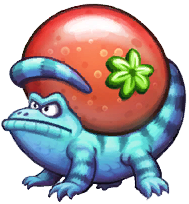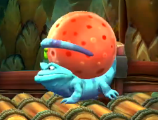Bouncelisk: Difference between revisions
(Undo revision 3780510 by 221.215.8.240 (talk)) Tag: Undo |
Tag: Mobile edit |
||
| Line 14: | Line 14: | ||
|Jap=ベリザード<ref>「ドンキーコングトロピカルフリーズ任天堂公式ガイドブック」 (''Donkey Kong Tropical Freeze Nintendo Kōshiki Guidebook''), [[media:DKTF Shogakukan P18.jpg|page 18]].</ref> | |Jap=ベリザード<ref>「ドンキーコングトロピカルフリーズ任天堂公式ガイドブック」 (''Donkey Kong Tropical Freeze Nintendo Kōshiki Guidebook''), [[media:DKTF Shogakukan P18.jpg|page 18]].</ref> | ||
|JapR=Berizādo | |JapR=Berizādo | ||
|JapM=Portmanteau | |JapM=Portmanteau of "berry" and "lizard" | ||
}} | }} | ||
Revision as of 03:25, December 28, 2022
| Bouncelisk | |
|---|---|

| |
| First appearance | Donkey Kong Country: Tropical Freeze (Wii U) (2014) |
| Latest appearance | Donkey Kong Country: Tropical Freeze (Nintendo Switch) (2018) |
Bouncelisks[1] are enemies seen in Donkey Kong Country: Tropical Freeze and its Nintendo Switch port. They appear to be blue, striped lizards with long and coiling tails. Their name seems to be a portmanteau of the words "bounce" and "basilisk" (the common basilisk is a real-world species of lizard). They only appear in the Juicy Jungle area of the game.
Bouncelisks carry red berries on their backs. The Kongs can jump and bounce on the berry to gain a lot of height, enabling them to reach and collect some items. When a Bouncelisk sees the Kongs, it will move towards them hastily, attempting to bump and injure them. However, Bouncelisks can be stunned by hand slapping the ground near them, or can be defeated by attacking them with a roll attack or a barrel.
Names in other languages
| Language | Name | Meaning | Notes |
|---|---|---|---|
| Japanese | ベリザード[2] Berizādo |
Portmanteau of "berry" and "lizard" |
